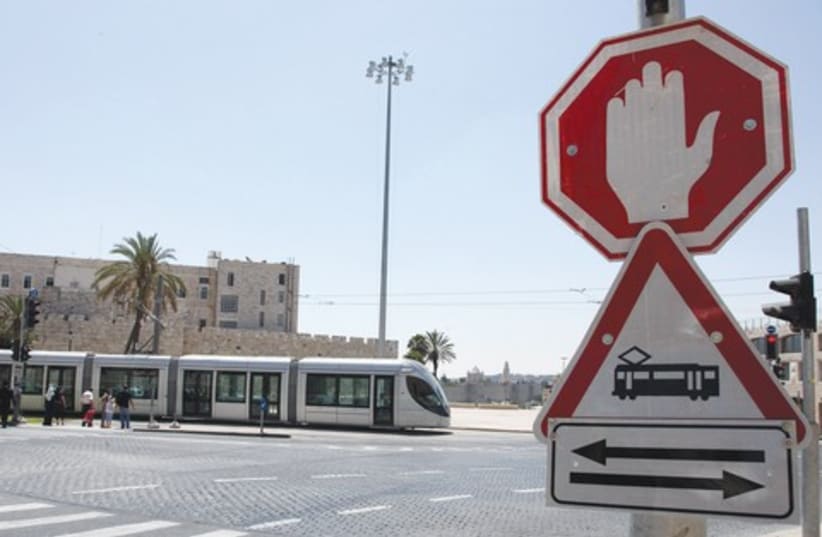Globes: When will the work begin to embitter the lives of the Dan Region’s residents?Shenhar: “I wouldn’t use the word ‘embitter,’ but I can say that the intensive period of the work will be in 2013- 15 when the tunnels are dug and the train stations are built.”Will you meet the 2017 deadline?“We opted for an ambitious, but possible, work plan. It’s true that it’s difficult to integrate all the contractors working on the project, but we’re strongly backed by Parsons Brinckerhoff, a global leader in project management, which will focus on this issue.”Are you worried about errors and faults? “We saw and learned from similar projects around the world. The main lesson is that there will be mistakes, but so long as the continuity of decisionmaking isn’t derailed, progress is possible.We’ll closely work with a steering committee, and we have the support of the Transportation Ministry and the Finance Ministry, so I’m optimistic.”
In Jerusalem, the municipality caused many problems for the light-rail franchisee CityPass. You have five municipalities to deal with.“We have excellent relations with the mayors, and they have representatives on the steering committee. Besides, as a government company, I believe that it will be much easier for us to get the necessary permits and authorizations.”Assaf Shenhar, 36, has accompanied the Tel Aviv light-rail project since 1998 when she was a junior worker in the Finance Ministry’s budget department.Since then she has been involved in pushing through approval for the route of the Red Line from Petah Tikva to Bat Yam via Bnei Brak, Ramat Gan and Tel Aviv.In 2006, after two years as economic adviser to the director-general of the Prime Minister’s Office she joined NTA.That year MTS, a consortium of Africa- Israel Investments Ltd., Egged Bus Cooperative, Siemens and Portuguese and Chinese companies won the BOT tender to build and operate the project for 25 years. NTA’s role was secondary: to promote the plan, clear infrastructures on the route and engage in information activities.Over the years, NTA was criticized for wasting resources and political appointments to its senior executive positions. Most problematic of all was NTA’s relationship with Mesilot, a transportation consultancy firm. In 1998, shortly after its establishment, NTA handed over responsibility for managing the project to Mesilot, which is owned by Ami Metom. Mesilot prepared the tenders to choose a franchisee for the Red Line.In 2006, the State Comptroller’s Office was harshly critical of the connection between NTA and Mesilot, which was supposed to last for one year but had continued for many years. Over the years, Mesilot had increased the scope of its work substantially, and its workforce had risen from 12 to 70 employees at salaries verbally agreed to with NTA.In total, NTA paid Mesilot more than NIS 300 million, and the work that Mesilot undertook for that huge amount became virtually worthless, after the government decided to nationalize the project. When former MK Michael Ratzon became NTA’s chairman, he was amazed to discover that the government company had no professional capabilities because almost all its staff and data banks were controlled by Mesilot.“Mesilot received NIS 350 million for coordinating the planning of a project that had not begun,” Shenhar said.“They took out the entire engineering unit from NTA, so that there were 70 people at Mesilot, and just two at NTA. I warned several times that we had no control over the know-how.”In August 2010, the government decided to cancel MTS’s concession agreement, after it failed to gain bank financing for the project. In December 2010, the government nationalized the project and handed it over to NTA. The general manager of a medium-sized company, Shenhar suddenly found herself in one of the most important and prestigious management positions in the public sector. Colleagues in the infrastructures sector raised their eyebrows.“There is no doubt that she is talented,” a person familiar with the matter said about her, “but she comes without any experience in megaprojects or professional knowledge about trains. No private company would dream of letting her manage a NIS 12 billion project. This could only happen in public service.”Looking back, even Shenhar’s critics admit that she has not done badly in the job. The project is moving forward as planned; more than 20 international tenders were issued in 2011, and the major construction tenders for building stations and digging tunnels will be published at the start of 2012.Project-management company Parsons Brinckerhoff has been hired as a senior consultant, mainly to handle the integration of the various contractors.NTA’s workforce has tripled to 100, and its operating budget has grown to NIS 30m.
